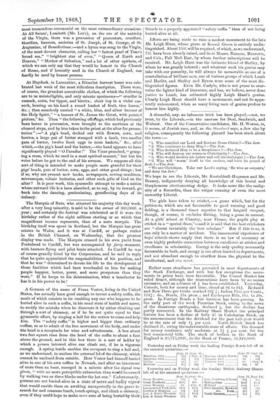A German of the name of Franz Vester, living in
the United States, has actually been good enough to invent a safety coffin, the .merit of which consists in its enabling any one who happens to be buried alive in such a coffin, in his usual state of health and nerve, -to rectify the mistake when he discovers it by either climbing out through a sort of chimney, or if he be not quite equal to that gymnastic effort, by ringing a bell for the sexton to come and help him. The "safety coffin" is higher and bigger than ordinary -coffins, so as to admit of the free movement of the body, and under the head is a receptacle for wine and refreshments. A box about two feet square rises from the head of the coffin to about a foot -above the ground, and in this box there is a sort of ladder by -which a person interred alive can climb out, if he is vigorous enough. A spring inside enables the occupant to ring a bell and, as we understand, to unclose the external lid of the chimney, which -cannot be unclosed from outside. Herr Vester had himself buried -alive in one of his own coffins in Newark, and after an interment -of more than an hour, emerged in a minute after the signal was given, "with no more perceptible exhaustion than would be caused by walking two or three blocks under the hot sun." Unfortunately, -persons are not buried alive in a state of nerve and bodily vigour that would enable them on awaking unexpectedly in the grave to search for and consume lunch, touch springs, and climb a chimney, even if they could hope to make more sure of being buried by their
friends in a properly appointed "safety coffin" than of not being buried alive at all.






























 Previous page
Previous page